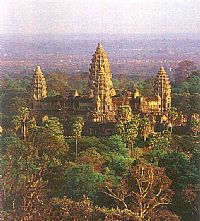 Angkor Wat, Siem Reap Cambodia |
While looking toward the year ahead, we decided to take a look back in time - at time, as in how ancient civilizations used their remarkably advanced knowledge of the skies to create calendars, calculate eclipses and determine major life events. Here is our list of the greatest examples of ancient sites dedicated to studying the heavens. Perhaps most remarkable is that these diverse civilizations, spanning five continents and reaching as far back as 3200 BC, devised astonishingly smiliar techniques and theories.
Angkor Wat (Cambodia)
Constructed during the early 12th century AD by King Suryavarman II, Angkor Wat stands as one of Asia's grandest religious mounuments and the benchmark of classical Khmer architecture. Yet this temple, renowned for its detailed bas-refliefs and carved devatas, was built not only to pay tribute to Hindu deities, but to reveal cosmological mysteries, as well. On the morning of the vernal equinox, for instance, the sun rises directly over Angkor Wat's central tower when observed from the temple's western causeway. In addition, the solstice sun illuminates specific segments of bas-reliefs, particular panels of which - such as the Churning of the Sea of Milk (Milky Way) - reveal their own calendrical secrets.
Chichen Itza (Mexico)
While Europe was in the midst of the Dark Ages, the Maya - a highly advanced people originating in the Yucatan and eventually inhabiting a vast region across Mesoamerica - created a writing system; a complex numbering system, including the earliest known concept of zero; and three distincitve calendars. Chichen-Itza, which was built between AD 700 and AD 1000 during the Mayan "Golden Age", served as the region's political, religious and military power, and claims some of the Maya's grandest structures. Its most famous, the El Castillo pyramid, was constructed so that, on the vernal equinox, the setting sun casts a shadow in the shape of a serpent slithering down the pyramid's steps. The Observatory traces Venus's travels across the sky.
Chaco Canyon (United States)
Situated in the remote, northwest corner of New Mexico, Chaco Canyon shows evidence of human inhabitance as far back as 2900 BC, although the massive, multi-story stone structures for which it is famous were constructed between AD 850 and AD 1150. Most of these great houses - some of which contained up to 700 rooms - were built along celestial alignments, indicating the expert knowledge Chacoans had of the skies and their influence on the seasons. The canyon's most famous ceremonial site, the Sun Dagger petroglyph, denotes the cycles of sun. Chaco Canyon National Monument was established in 1907 and, 80 years later, it was designated a UNESCO World Heritage Site.
Karnak (Eygpt)
Ancient Eygptians believed that the sun god, Amon-Re, created the universe and, in reverence to this foremost diety, they constructed one of the greatest monuments in the world. Located less than two miles from (and virtually synonymous with) Luxor, the humbling Temple of Karnak - built over a period of almost 2000 years - actually comprises three main temples, along with a number of smaller temples. While dedicated to the sun god, the Karnak complex is believed to have at least four stellar alignments; archaeologists believe that many of the temples were altered over the centuries to follow the processional movements of their aligned stars.
Jantar Mantar (India)
One of six major observatories built by Maharaja Sawai Jai Singh II (AD 1688-1743), Jantar Mantar in Jaipur allowed ancient priests to measure time, calculate eclipses, determine the Earth's circumference - even theorize about gravitation - with incredible accuracy. Astronomy played a major role in ancient India, as evidenced by a tour of the Jantar Mantar site. Its equatorial sundial, Laghu Samrat Yantra, can measure time to within 20 seconds, while the site's hemispherical sundials (called Narivalaya) determine the positions of both the sun and stars. The Rashi Yantras, or zodiacal instruments, observed latitues and longitudes of the planets.
Machu Picchu (Peru)
Although the ancient Inca reigned over the largest pre-Coumbian empire in the Americas - an estimated 440,000 square-mile region extending from Ecuador to the Chilean coast - many of the civilization's greatest feats were lost to conquering Spaniards and the ravages of time. Yet the great city of Machu Picchu - located high in the Andes Mountains and surrounded by dense foliage - stands as a testament to the Inca's accomplishments. Many of the city's structures were built in celestial alignment; the central intihuatana (which translates to "tying the sun") is a stone platform where priests would hold ceremonies to "tie" the sun to prevent it from disappearing during the winter solstice.
Newgrange (Ireland)
Located in County Meath northwest of Dublin, Newgrange is famous for its megalithic tomb, an acre-sized mound constructed around 3200 BC. At sunrise on the winter solstice, the tomb's 62-foot-long inner passage and chamber are dramatically illluminated for approximately 20 minutes. Designated a UNESCO World Heritage Site in 1993, the Newgrange chamber is decorated with a prominent, megalithic tri-spiral design; upright stones both in and outside the chamber are engraved with other designs and images. Tours of Newgrange - along with the smaller tombs that lie nearby at Knowth and Dowth - are available through the Bru na Boinne Visitor Centre in Donore. Admission to watch the winter solstice sunrise, however, is held by lottery.



